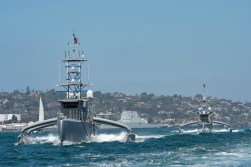Navy No. 1 stresses improved IT, cybersecurity on ships in Navy of the future

Acting Sectary of the Navy Thomas Modly said Wednesday he plans in a “couple days” to submit to the secretary of Defense his plan to build the Navy of the future, which will rely heavily on improved IT communications and cybersecurity on ships.
Modly stressed the need to think beyond just ships in the Force Structure Assessment, the Navy’s plan to grow its fleet to 355 vessels up from the roughly 290 it has today. Cybersecurity is an emerging domain of warfare that Modly said he is focused on, particularly as the Navy has struggled with cybersecurity, stinging reports have found.
The Indo-Pacific is “a maritime, space and cyber theater,” he said at a Center for Strategic and Budgetary Analysis event.
A new Center for Strategic and Budgetary Analysis report backs this thought, insisting that the Navy will need improved communications technology and other new cyber capabilities as adversaries grow stronger if it hopes to increase its size and stay dominant while afloat.
“Arguably the most important operational challenge to address will be command and control (C2) of distributed naval forces when decision-making superiority is an objective,” the CSBA report states.
Ramping up the Navy’s presence in the Indo-Pacific, and especially in the South China Sea, is a key part of the National Defense Strategy that calls China the U.S.’s No. 1 “strategic competitor.” Beyond conventional kinetic warfare, technology will play a large role in future conflicts, according to another report from the Center for New American Security, released Tuesday.
“The United States and China are locked in strategic competition over the future of the Indo-Pacific—the most populous, dynamic, and consequential region in the world,” that report states.






